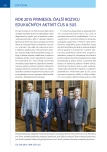-
Medical journals
- Career
LAPAROSCOPIC RESECTION OF LEIOMYOMA OF TRIGONE OF URINARY BLADDER
Authors: Milan Hora 1; Petr Stránský 1; Viktor Eret 1; Kristýna Kalusová 1; Tomáš Pitra 1; Ondřej Hes 2
Authors‘ workplace: Urologická klinika LF UK a FN Plzeň 1; Šiklův ústav patologie LF UK a FN Plzeň 2
Published in: Ces Urol 2015; 19(4): 253-255
Category: Video
Overview
There are many cases of less common and rare diagnoses in medicine with no standardized guidelines and we have to try to take advantage of some therapeutic modality that is known from other more common diagnoses.
Case report (video):
A 42 y/o man, investigated for dysuria, on US, CT and 3T MRI was found to havea round mass 6cm in diameter in the bladder trigone. The finding was verified endoscopically and a biopsy under endoscopic control was taken using a “core” needle through the lower abdomen. Histology confirmed leiomyoma and surgery was planned. We intubated both ureters with single - loop stents using flexible cystoscope in supine position and introduced a urinary catheter. The patient was placed head down (Trendelenburg position). We used Veres needle for creation of pneumoperitoneum (12 mmHg), transumbilically introduced videotrocar 10 mm and under visual control other trocars – 2x5 mm and 1x11 mm. Transperitoneally at the base of the bladder we opened the posterior peritoneum transversally and urinary bladder longitudinally on the posterior wall. We used a harmonic scalpel during the surgery. The mass was gradually reflected from surrounding tissue including adjacent bladder wall. Both ureters (the left running along the mass) were freed. We sutured the trigone defect using V-Loc™ 90 3–0, the bladder wall with the same suture and then peritoneum with another suture. The operation time was 127 minutes with no blood loss. The specimen was extracted, histologically again evaluated as leiomyoma. We removed the urinary catheter after cystography on day 6 postoperatively. This man has now been 7 months after the surgery without any difficulty.Conclusion:
Laparoscopy allows to treat even less common diagnoses, such as leimyoma localised on the bladder trigone.KEY WORDS:
Urinary bladder, leiomyoma, laparoskopy
Sources
1. Patrozos K, Westphal J, Trawinski J, Wagner W. Total laparoscopic excision of a leiomyoma of the urinary bladder – a case report. Aktuelle Urol. 2005 Feb; 36(1): 58–60.
2. Lee TK, Miyamoto H, Osunkoya AO, Guo CC, Weiss SW, Epstein JI. Smooth muscle neoplasms of the urinary bladder: a clinicopathologic study of 51 cases. Am J Surg Pathol. 2010 Apr; 34(4): 502–509.
3. Park JW, Jeong BC, Seo SI, Jeon SS, Kwon GY, Lee HM. Leiomyoma of the urinary bladder: a series of nine cases and review of the literature. Urology. 2010 Dec; 76(6): 1425–1429.
4. Singh O, Gupta SS, Hastir A. Laparoscopic enucleation of leiomyoma of the urinary bladder: a case report and review of the literature. Urol J. 2011 Spring; 8(2): 155–158.
5. Ortiz M, Henao DE, Cardona Maya W, Ceballos MM. Leiomyoma of the urinary bladder: a case report. Int Braz J Urol. 2013 May-Jun; 39(3): 432–434.
6. Muoka OE, Muoka O, Daruwalla P. Leiomyoma of the bladder. BMJ Case Rep. 2013 Mar 25; 2013.
7. Al-Othman KE, Rajih ES, Al-Otaibi MF. Robotic extramucosal excision of bladder wall leiomyoma. Int Braz J Urol. 2014 Jan-Feb; 40(1): 127–128.
8. Goktug GH, Ozturk U, Sener NC, Tuygun C, Bakirtas H, Imamoglu AM. Transurethral resection of a bladder leiomyoma: a case report. Can Urol Assoc J. 2014 Jan-Feb; 8(1–2): E111–113.
9. Bera MK, Pal K. Bladder leiomyoma: a case report. J Indian Med Assoc. 2011 Apr; 109(4): 272–273.
Labels
Paediatric urologist Nephrology Urology
Article was published inCzech Urology

2015 Issue 4-
All articles in this issue
- INFECTED CYST CAUSING A MECHANICAL SYNDROME AS A COMPLICATION OF A RENAL CELL CARCINOMA
- LAPAROSCOPIC RESECTION OF LEIOMYOMA OF TRIGONE OF URINARY BLADDER
- TREATMENT OF LOCALIZED AND LOCALLY ADVANCED PROSTATE CANCER FROM A UROLOGIST‘S AND RADIATION ONCOLOGIST’S POINT OF VIEW.
- CELL CULTURE MODELS OF UROTHELIAL CARCINOMA CHEMORESISTANCE
- ESTABLISHMENT AND CHARACTERIZATION OF MULTIDRUG RESISTANT CELL LINE MODEL OF UROTHELIAL CARCINOMA
- PATIENTS’ RADIATION DOSES DURING PERCUTANEOUS NEPHROLITHOTOMY FOR URINARY STONES IN THE UROLOGICAL DEPARTMENT, ČESKÉ BUDĚJOVICE HOSPITAL
- SEVEN YEARS EXPERIENCES WITH APLICATION OF SHOCK WAVES TO MEN WITH PEYRONIE‘S DISEASE
- SYNCHRONOUS BILATERAL TESTICULAR SEMINOMA
- Czech Urology
- Journal archive
- Current issue
- Online only
- About the journal
Most read in this issue- SEVEN YEARS EXPERIENCES WITH APLICATION OF SHOCK WAVES TO MEN WITH PEYRONIE‘S DISEASE
- SYNCHRONOUS BILATERAL TESTICULAR SEMINOMA
- INFECTED CYST CAUSING A MECHANICAL SYNDROME AS A COMPLICATION OF A RENAL CELL CARCINOMA
- TREATMENT OF LOCALIZED AND LOCALLY ADVANCED PROSTATE CANCER FROM A UROLOGIST‘S AND RADIATION ONCOLOGIST’S POINT OF VIEW.
Login#ADS_BOTTOM_SCRIPTS#Forgotten passwordEnter the email address that you registered with. We will send you instructions on how to set a new password.
- Career

